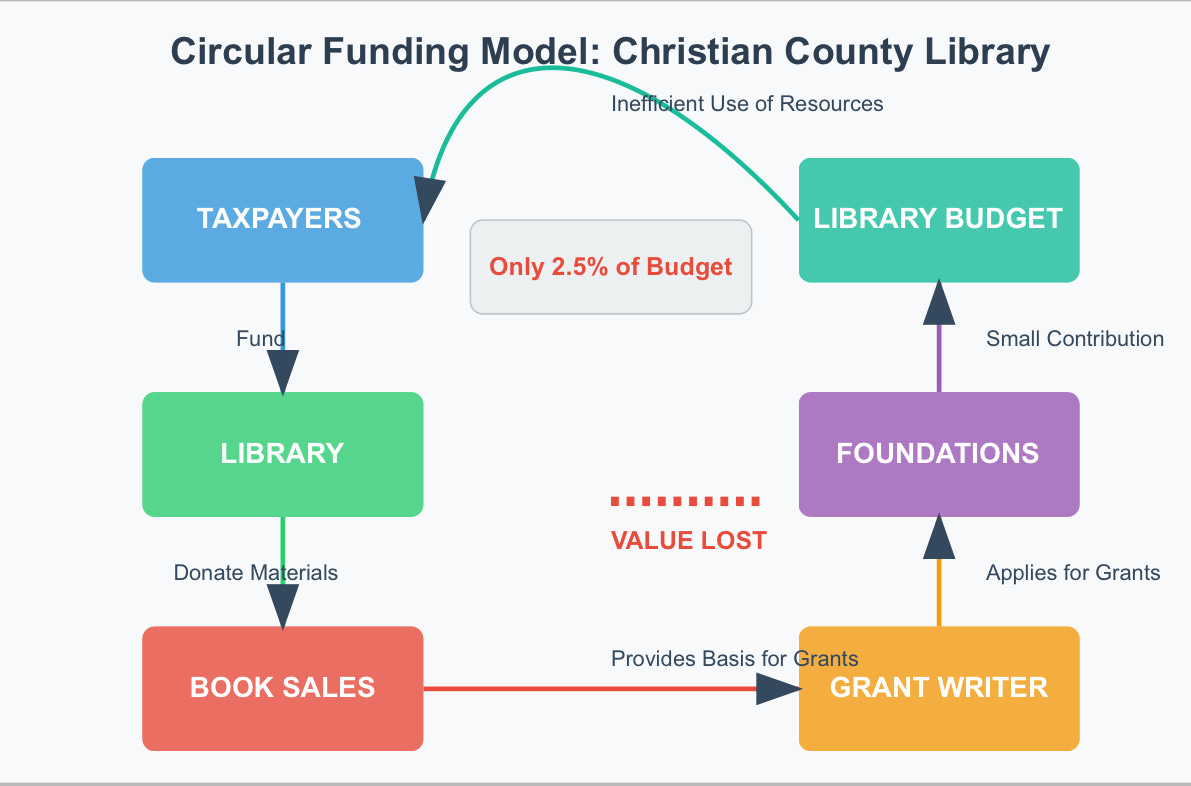The Curious Case of Library Support: Questions About Christian County's Foundation Model
As these two Foundations show up and try to speak out in the media and social media, are they actually providing value, or is their virtue signaling taking money from taxpayers?
Two Foundations—Almost no Return
The Christian County Library, like many public libraries across America, has cultivated relationships with supporting organizations designed to bolster its mission. In this case, two distinct entities have emerged: the Christian County Library Foundation and the Friends of the Christian County Library. These organizations present themselves as vital pillars of support for the library system, but a closer examination of public records reveals a more complicated picture.
Both organizations file what's known as Form 990-N with the IRS—an "e-Postcard" filing option available only to tax-exempt organizations whose annual gross receipts are normally $50,000 or less. This simple fact establishes an important baseline: neither organization is raising substantial funds relative to the library's overall budget.
Follow the Money: A Circular Path
The most intriguing aspect of this relationship concerns the Friends of the Christian County Library. According to their website, their primary fundraising mechanism involves book sales. These aren't just any books, however—they're largely materials that originate from the library itself.
This creates a circular pattern of resource flow:
The library purchases materials with taxpayer funds
After these materials serve their circulation purpose, they're donated to the Friends group
The Friends group sells these items at modest prices ($0.50 to $2.00)
A portion of these sales returns to the library as "grants"
Meanwhile, the library maintains a grant writer position whose responsibilities include securing funds from these very organizations. This adds another layer to the circular flow: taxpayer money funds a position dedicated to retrieving a fraction of the value of taxpayer-funded resources that were originally donated by the library.
The Numbers Tell a Story
While detailed financial information awaits disclosure through a Sunshine Law request, some basic math reveals the limited scope of this support. With both organizations reporting under $50,000 in annual gross receipts, their combined maximum possible contribution represents roughly 2.5% of the library's estimated $4 million budget.
This percentage becomes even more striking when considering the administrative costs associated with maintaining these separate entities—officer positions, event planning, grant applications, and the portion of library staff time dedicated to coordinating with these organizations.
Appearances vs. Reality
What purpose, then, do these organizations serve? One possibility is that they create an appearance of robust community support and successful fundraising—useful narratives for library administrators and board members. The Friends group states on their website that their "#1 priority is to provide additional funding for materials and services not covered by the library's budget." Their listed accomplishments include "Summer Reading Challenges, book bins in the children's areas at every community branch location, a new service desk in Ozark and programming supplies."
These are worthy contributions, but they seem disproportionately small compared to the administrative infrastructure built around them.
Questions Worth Asking
As taxpayers and library patrons, community members might reasonably ask:
What is the actual value of materials donated to the Friends group annually?
What percentage of sales revenue makes its way back to the library?
How much does the library spend on grant-writing efforts directed at these organizations?
Would a direct sales model managed by the library itself be more efficient?
Could the resources currently devoted to this circular funding model be better utilized?
A pending Sunshine Law request seeks answers to these and other questions. Until then, the limited public information available suggests that the relationship between the Christian County Library and its supporting organizations may be more about maintaining appearances than delivering substantial financial value.
In a time when libraries face increasing budget pressures and scrutiny, ensuring that every dollar delivers maximum value for patrons should be a priority. The current arrangement—where resources make a full circle with diminishing returns at each step—warrants closer examination.
Note: This analysis is based on publicly available information including IRS filings and organizational websites. A more definitive assessment awaits detailed financial disclosures through Missouri's Sunshine Law.













I think exploring the funding of nonprofits that support a library is important and I am glad you are writing about it, honestly. I am not from this area so I am going off information what you and others have written about plus some anecdotal knowledge. With that said, though, I have a few points of contention on your piece:
A key consideration you might be overlooking in your argument is that a significant portion of the Friends of the Library inventory for selling probably comes from community donations rather than the emphasis you place on book sales being generated from old library materials. At my library, the majority of books sold at these fundraising events are donated directly by the public. If Christian County operates similarly, this means the Friend of the Library is generating some of this revenue from materials the library has never purchased. While you argue that the financial return for the library is weak, I would emphasize that any additional funding stream, even if it is not a significant chunk of a large system budget, has value. Even more so when it requires minimal library resources and is largely facilitated by local volunteers who, from what I see through the websites, have care for your community.
Say the non-profit (Friends of Library) related to the library ceased to exist or dissolved. What does the alternative look like? Without a non-profit group partnering with a library, the old books no longer suitable for being in the library would likely be discarded, thrown away...shoot they may have to be recycled which would cost money for the library. Or, say the library wants to recoup the costs of their old books: They could start listing the books on ebay or marketplace...but there are caveats in the selling arena: Lest we forget, the library would probably now have to handle sales-tax collection, manage online seller fees, and dedicate more staff hours to selling materials that were already deemed past their useful life in the collection. I feel like the administrative overhead alone would likely swallow any marginal gains, turning into more of a net drain on taxpayer resources.
I also would say that giving the books a second life through a community sale fosters literacy in the community by providing low-cost books to the community with an eventual payback for the library through grants in return. At least in this way, some value is recaptured for the library including books that were donated to the sell that the library never spent money on before.
I would also add that a non-profit, like your Friends of the Library, could provide an extra layer related to positive stewardship of funds. With the way you have historically written about the Christian County Library mishandling funding and having less than ideal visions for the library, it would seem rather beneficial that this money from the book sales, even though it is small, would be stewarded by a group outside of the library leadership, right? This group is made up of volunteers from the community, so who better to steward the money than those in the community the library serves? For example, the library wants to buy a new desk. They would probably have to make a case to the non-profit Friend group about what they need funds for. The Friends of the Library then decides if that is something they would be willing to fund with their budget. The library has to make a case for their needs, which provides another layer of authority and approval on how money is being spent.
I’m not saying the system is perfect, but calling it inefficient or implying it’s some kind of circular, self serving model feels more misleading than not. To me, the way it was described seems like a practical way to stretch limited resources and recoup costs as much as you can to benefit a library, even if it is just for something like a service desk.
I don't say any of this in an angry or mean tone...I came across your blog whilst doing some research related to publicly funded organizations...I hope what I said makes sense